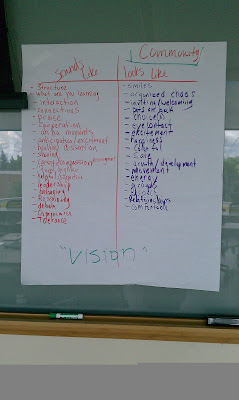1. Setting norms, rules, guidelines. So many teachers on the first day of school sit or stand in front of their classes and lecture students on the rules they are expected to follow. Instead, why not ask students to help create those norms. One way to do this is to have students individually brainstorm a list of what they need in a classroom to be successful learners. They can pair-share their lists and then as a class, create a master list of what they feel are the necessary conditions. Using these conditions, the teacher can then ask, "If these are the conditions we need to be successful learners, what norms or guidelines could we create and follow to ensure the conditions are met?" Different groups will need differing amounts of support to create these guidelines. Sometimes, they can be very abstract, such as "We will respect each other." That's ok, but what I have found with abstract norms like this, it can be very helpful to create a Sounds Like/Looks Like T-chart. This will produce a concrete list of actions to guide behavior. I always end the process of developing norms by having the students create a "warning" word or phrase; something we can quietly say to one another when we are getting off-track in following our norms. I also wrote about another protocol for creating norms here. This was done with adult learners, but I think would work just as well with children.
 |
| These are the norms created by my graduate class this summer. The chart paper below the norms is their list of conditions necessary for a successful learning environment. |
2. Setting procedures. Teachers put a lot of thought into the procedures they use in their classroom. That's good. Good planning for transitions, for when and how to sharpen pencils or turn in papers, or for what a student should do after returning from an absence make a classroom function in a smooth and efficient manner. What if we let the students develop these procedures? We might be surprised when their ideas make more sense than our own. And when students have a voice in the way things are run, they are much more likely to remember those procedures!
3. Starting the year without rules. I wish I could remember where I read about a teacher who actually did this. But I did read it in either a blog or a classroom management book. I admit, it would scare me to try it! But in spite of my fear, I can still see the power behind letting students come to the realization that guidelines are necessary in the successful functioning of a class or a school...or a society!
4. Giving students a voice in the curriculum. I am a firm believer in teaching through an integrated curriculum. But teaching this way requires a shift in paradigm that many teachers lack the knowledge of and courage to try. Mandates in certification require us to be "specialists" in an area and quite often at the middle and high school level, teachers see themselves as a teacher of their content rather than a teacher of students. But there are ways to add student voice to the curriculum. One way is add choice. When creating assignments or assessments, give options for students to choose from. Teachers can also give students a voice in driving the curriculum. If you are a science teacher and you are teaching a unit on space, show students the benchmarks you are required to help them meet, tell them about some of the content and then ask them to brainstorm questions they have about the topic. Their questions can become the essential questions that drive the unit.
If you center your units around a concept rather than factual content this becomes even easier. One activity for gleaning curriculum from a concept is to do a List-Group-Label. The pictures below are an example of this process that my graduate class did as they began to plan an integrated curriculum around the concept of Change.
 |
| I was the guinea pig for this activity. The students asked me to make a list about change. |


